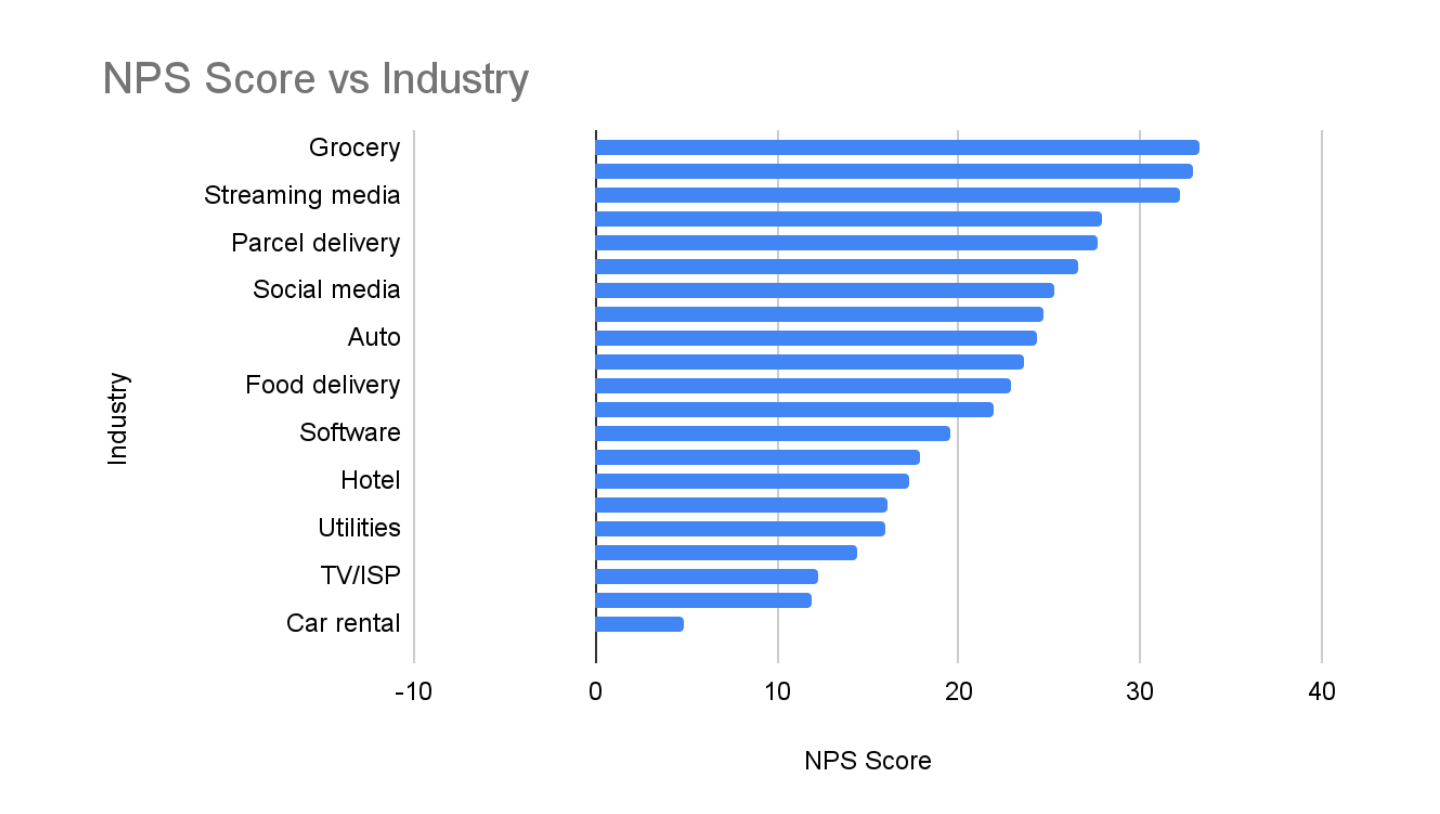
What Net Promoter Score is Considered Good?
Are my customers satisfied with my product and service? This is question business owners and employees often ask themselves. Of course, various methods exist for measuring customer satisfaction and collecting feedback. But most companies measure their net promoter score (NPS) to keep their fingers on the pulse.
What is NPS?
In simple terms, NPS allows us to quantify the level of customer satisfaction. Unlike extensive customer satisfaction surveys, NPS contains only one question: „How likely are you to recommend company X to a friend or colleague?” In response to this question, users pick a number from 1 to 10, where 10 means they would definitely recommend your products. If you think this isn’t a question about the level of satisfaction but about willingness to promote your product, think twice. The idea behind the question is simple: people are only open to recommending a product to their colleagues, friends, or family if they are satisfied.

How is NPS calculated?
Answers from 1 to 6 mean that a customer isn’t satisfied with the service, and people giving such a rating are called „detractors.” People who choose 7 or 8 are called „passives.” Those who pick ratings of 9 or 10 are called „promoters.”
So, how do we calculate NPS?
NPS = % of promoters – % of detractors
To put some real numbers to this calculation, let’s assume that 100 people reply to your NPS survey. Out of those, 40 people pick numbers 9 and 10, while 30 choose numbers 1 to 6. Your NPS would be:
40% – 30% = 10. In this case, your NPS is 10. So, is this a good score?
Why measure NPS?
Let’s take a step back and check why measuring NPS is so important.
NPS helps you understand overall customer happiness—how many of your customers are happy and how many are unhappy. NPS helps you measure customer loyalty and maintain a positive customer experience. Measuring NPS also helps you understand the overall condition of your company. If your NPS is falling, it means something is wrong, and it’s time to take action.
The three most common mistakes companies make with NPS
Lack of consistency
NPS should be measured regularly and not just from time to time. Many companies conduct NPS surveys only once per year. To make an NPS work, it should be measured throughout the year and the survey should be easily available for customers or users. On the other hand, companies that measure their NPS throughout the year sometimes forget about this indicator. In our company, NPS is a whistleblower. If it suddenly starts to fall, it means that something is going wrong. Too often, companies ignore this indicator or don’t pay enough attention to it.
Lack of understanding
You have to know what your customers are rating. If you send NPS surveys after an interaction with your company’s support team, the customer’s rating will probably refer to the level of customer service. If you measure NPS just after a customer has ordered a product in the e-store, that customer will probably focus on the purchasing process. If NPS is available in the panel of your software, customers will evaluate the product. Remember the context of where and when you ask your customers to leave their ratings.
The second issue is the lack of follow-up. If a customer rates your product at 2, it’s worth asking them why they left this review. Maybe they weren’t satisfied with the answer they received from your support or had a problem with the website. It’s worth following up with unhappy customers to better understand what influences NPS.
Read Also: How to Decrease your lead response time.
Lack of action
If your company has a positive NPS and your average score is way above the industry average, you can consider yourself lucky. Your customers will stick with your product and most likely recommend it to others. There is no better marketing strategy than the positive experience of existing customers.
But if your NPS is low, you have a problem that needs action. Too often, companies faced with a bad NPS don’t do anything about it. It doesn’t mean you have to panic. Instead, go back to mistake 2 and start by analyzing your customers’ ratings and check why they are unhappy. Sometimes, you only need to make small changes to improve your NPS. If the issue is larger, don’t get discouraged. Make a plan to improve the situation. You already have what you need—you have the knowledge.
What is a good NPS?
Let’s get back to the questions that led you to this article. What NPS is considered good? Unfortunately, there is no universal number that will tell you if your NPS is good. NPS will differ based on the industry, the country you operate in, and your customer profile. In some cases, people tend to give higher scores, and some people are more critical. Also, as we mentioned in the section on mistakes when measuring NPS, the score will depend on your survey channel.
There is only one universal rule for your NPS: it’s always worth analyzing how your average NPS changes over time. If your NPS is falling, it’s a clear signal that something is wrong. If it’s increasing, good job. You seem to be on the right track. After all, NPS is mainly used to understand how your product or service changes over time and to keep an eye on how your company is doing.
If you’re just starting to use NPS surveys and don’t have a number to compare results to, you can use the industry average NPS to check if your company is above or below this average.
Read Also: How to Improve Customer Engagement.
NPS benchmarks by industry
For the purpose of this article, we checked the benchmarks published by NPS survey providers. According to Questions Pro, the highest average NPS is achieved by companies in the insurance industry (the benchmark for 2022 is 77). The NPS in other industries is as follows:
- Consulting: 68
- Technology & Services: 61
- Digital Marketing Agency: 60
- Construction: 45
- Logistics & Transportation: 43
- B2b Software & SaaS: 40
- Ecommerce: 62
- Retail: 61
- Financial Services: 56
- Healthcare: 38
- Communications & Media: 29
According to Trustmary, the NPS for top industries looks like this:

Delighted has developed a comparison engine where you can provide your NPS, pick your industry, and easily compare your results against the industry average.
Other factors influencing your NPS
In addition to the industry in which you operate, there are other factors that can affect your company’s NPS.
Overall market situation
The average NPS per industry varies over time and looks different from year to year, and there is a notable relationship between the overall NPS level and the global market situation. This was most visible during the Covid-19 pandemic when the score for industries particularly affected by restrictions—such as travel and accommodation—was hit hard.
Survey distribution channels
As we mentioned earlier, where your customers leave the vote, can be crucial to understanding your NPS. Go back to the section on common mistakes for more information.
Regional differences
It’s important to evaluate the country or region in which your company operates. Generally speaking, people in Europe are more cautious with their ratings and rarely reward a company with a 10. In their minds, a 10 is reserved for exceptional service. It is much easier to get a 9 or 10 in countries like the U.S., Brazil, or India, where people are more often promoters.
Takeaways
In this article, we summarize the basics of NPS, present industry benchmarks, and explain the factors that can affect your NPS. These are the key points that you should take away after reading this article:
- Measure and control your NPS over time. The advantage of measuring NPS is that it helps you maintain control over your company’s situation. NPS can be a great indicator of what’s going on in your company, so compare scores over time. If it’s falling, react.
- Try to get a deeper understanding of negative feedback. Ask customers who give a low rating to fill out additional surveys, or (if you have the resources) try to talk to them in person. Understanding the real reason for lower ratings is crucial for improving your NPS.
- Understand the context. There are low tolerance and high tolerance industries, people in different regions may rate the same level of service differently, and the survey distribution channel may affect your NPS. Consider all factors before deciding on your NPS.
- Don’t panic at low scores, but don’t underestimate them either. If your NPS is below the regional and industry averages, don’t panic. Try to identify your customers’ biggest pain points and work to fix them.
Start generating leads today!
Start a 14-day free trial now,
set up the widget on your site, and see how many more leads you can capture with CallPage
- No credit card required
- 10 minutes set up
- 14 days fully-featured free trial
